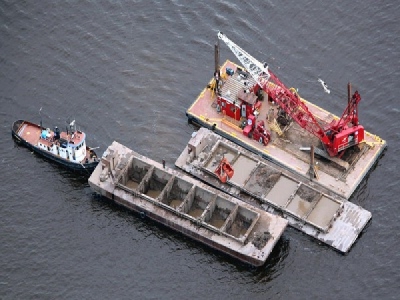
Posted on December 8, 2016
By Brady Slater, Duluth News Tribune
A busy year of projects on the westernmost Great Lakes saw $60 million poured into 254 construction and dredging contracts, the Detroit District of the U.S. Army Corps of Engineers reported in a news release early this month.
“These projects help the Corps further its mission of providing great engineering services and sustainable solutions to the Great Lakes Region,” said Lt. Col. Dennis Sugrue, district engineer, in the news release.
Modernization and maintenance work on and around the Soo Locks in Sault Ste. Marie, Mich., comprised roughly a third of that dollar figure.
The Soo Locks between lakes Superior and Huron comprise a vital link in the nation’s manufacturing supply chain.
Among 16 sets of locks on the Great Lakes, the Soo Locks specifically are integral to the nation’s steel industry as taconite iron ore mined on the Iron Range is taken by lake freighter from Duluth, Superior, Two Harbors and Silver Bay to the country’s steel mills — generally located along the Great Lakes. A 2015 study by the U.S. Department of Homeland Security said that 50 percent of the iron ore used by the country’s steel mills is shipped directly through the Poe Lock — one of two working Soo Locks and the only one capable of handling the 1,000-foot lake freighters that typically haul the tons of taconite iron ore pellets.
The Soo Locks are scheduled to close Jan. 15 for the annual offseason, ushering in roughly two months of intense work on the locks.
Dredging, as it always does, also comprised a large part of the Detroit District’s budget.
In the Twin Ports, two dredging contracts worth more than $2.6 million were awarded to separate contractors from Ohio and Wisconsin. Together, the ongoing dredging will result in almost 340,000 cubic yards of dredged material being taken out of shipping channels in the bays between Duluth and Superior.
“The dredging work removes the natural siltation that occurs in the 19 miles of authorized channels and can be compared to plowing the snow from city streets,” said Jim Sharrow, the Duluth Seaway Port Authority’s director of port planning and resiliency. “This work keeps the channels open for the waterborne movement of the raw materials so critical to the economy of Northern Minnesota and to industrial economy of North America.”
Much of the dredged material that tests as clean is being reused for habitat restoration in two locations within what is an aquatic habitat restoration site in the bay visible from 21st Avenue West.
“The goal of the project is to restore the aquatic habitat within the 350-acre site by placing the dredged materials to create optimal water depth and flow conditions that will help establish diverse aquatic vegetation and healthy benthic organisms,” said Nelson French, supervisor for the Lake Superior Unit of the Minnesota Pollution Control Agency based in Duluth.
The process will be repeated in other environmental hot spots along the St. Louis River estuary that are outlined in a project called the St. Louis River Remedial Action Plan. French said the project “is making a significant contribution to cleaning up” the estuary and called it a creative use of dredged material. For its creativity — dredged material has rarely been used in this manner before — the restoration project was a recipient of a 2016 Minnesota State Government Innovation Award from the Humphrey School of Public Affairs and The Bush Foundation.
Since the first pilot year in 2013, 510,000 cubic yards of navigational dredged materials has been placed at the site off of 21st Avenue West and work is expected to be completed in 2017, said French — with similar habitat restoration projects continuing farther up the river in the years that follow.
The president’s budget for fiscal year 2017 (ending in October) includes $67.5 million for the Detroit District but has yet to be approved by the United States Congress.
Source: Duluth News Tribune





